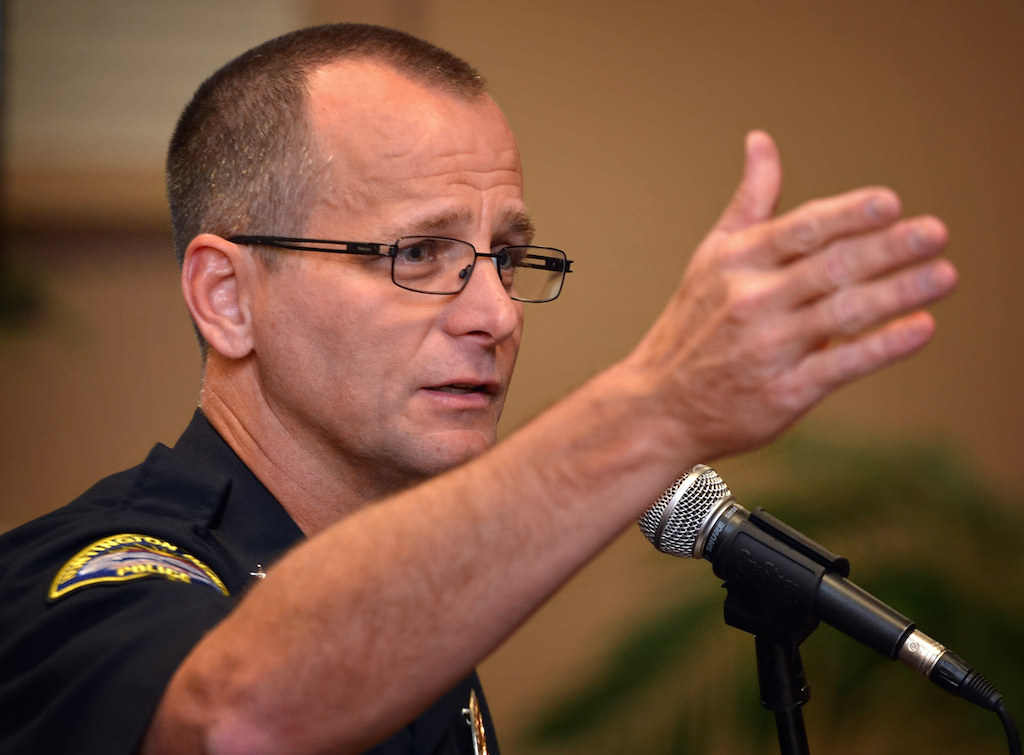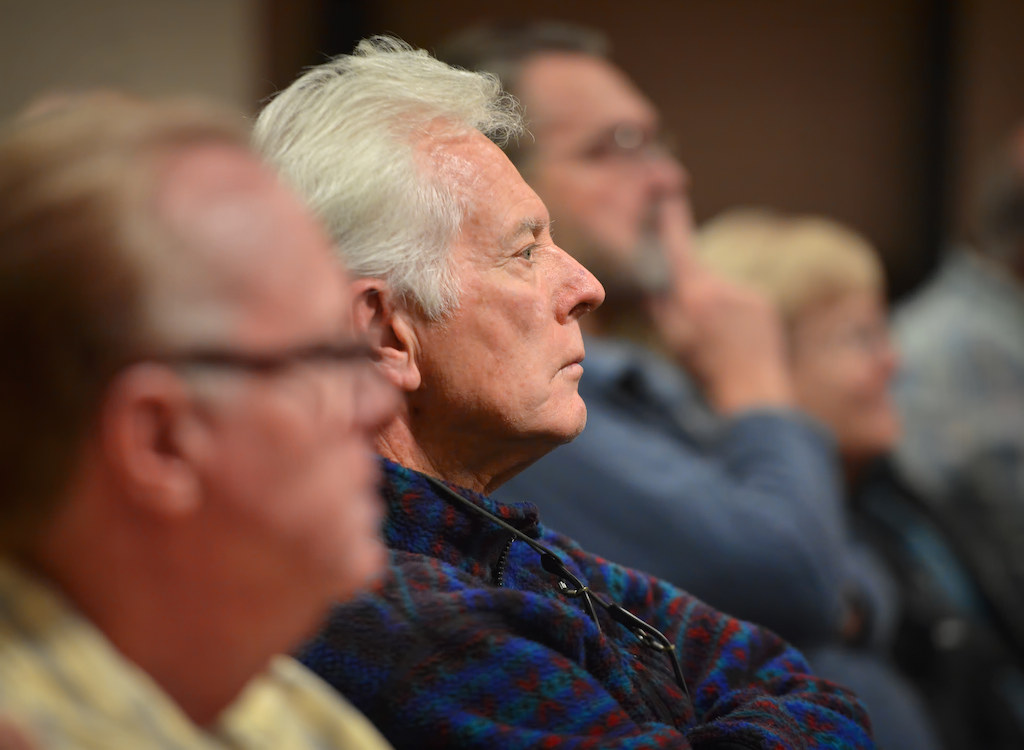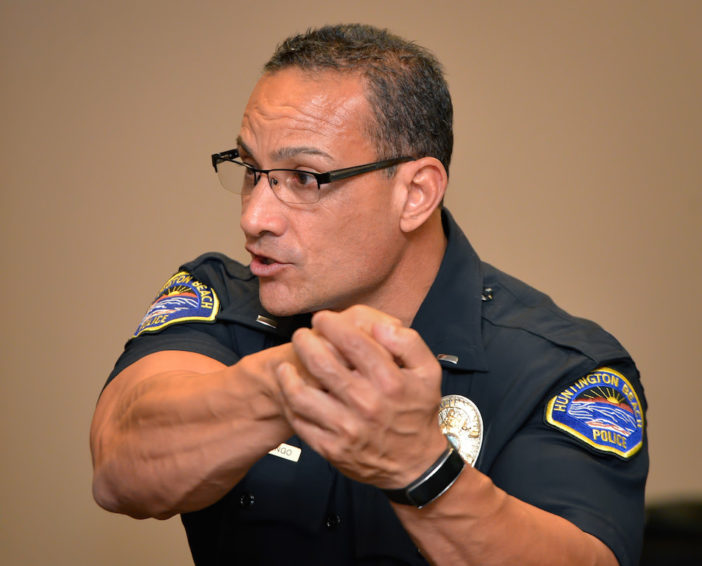Law enforcement officers often handle life-threatening situations with split-second decisions.
In a quarter of a second, a suspect can pull and fire a gun.
In 18 one-hundredths of a second, a fleeing suspect can turn, fire a shot, then turn back around to keep running.
The recent deaths of Michael Brown, Eric Garner and Ezell Ford have prompted pointed questions and biting criticism from the public and media on police use of force.
Huntington Beach police took the topic head-on Tuesday night in a candid community forum at the Huntington Beach Central Library.

Huntington Beach Police Chief Robert Handy talks to a group of people gathered for a Citizens Academy on Use of Force at the Huntington Beach Central Library.
Photo by Steven Georges/Behind the Badge OC
“It’s a side (of law enforcement) we don’t publicly discuss a lot,” said Police Chief Robert Handy. “Given the overall national climate with Ferguson, New York and … Los Angeles, we thought it was important to try and engage the community.”
More than 50 residents attended the event in a meeting room in the library’s theater.
The audience peppered Handy and Lt. John Domingo with questions about how officers are trained and what legal rights they have as citizens to use force in life-threatening scenarios, among other inquiries.
“Were do you aim?” one man asked.
“When do you call for backup?” a woman wanted to know.
Some in the audience, including City Councilman Billy O’Connell, wanted to say ‘thank you’.
“A lot of people aren’t aware of the challenges our police officers go through every day,” he said. “I’ve had the chance to look at our police logs and see our officers getting assaulted, spit on and other things.
“Thank you for all you do.”

John Craney of Huntington Beach, center, listens to a presentation on ‘Use of Force’ given by the Huntington Beach PD at the Huntington Beach Central Library.
Photo by Steven Georges/Behind the Badge OC
Handy said he hopes sharing law enforcement’s perspective may help the public better understand what plays a role in these intense situations that sometimes have tragic endings.
“We put so much pressure on our officers to make the best, most perfect decision and then they get second guessed afterward,” Handy said. “It’s a frustrating part of our job, but it’s necessary part of our job. We have to be second guessed afterward.”
ARRESTS WITH FORCE
In Huntington Beach, officers arrest thousands of people every year and use force in a couple hundred of those arrests.
Eighty-two percent of the people officers use force on are either under the influence of drugs or alcohol or suffer from a mental illness, police said.
“The perception is that we are out here having use of force incidents all day, every day,” Handy said. “In reality, we use force in less than 1 percent of our arrests.”
Although a small percentage of the department’s overall work, use of force encounters can have the gravest consequences.
“People die in our custody … those things happen in our profession,” Handy said. “On average, it happens once a year in Huntington Beach.
“But the dynamics of those things are very important for (the public) to understand. We lost that narrative as an industry.”
SPLIT-SECOND DECISIONS
How officers use force is not an exact science, Domingo said.
A suspect’s size, drug or alcohol use, age, mental illness and environmental factors all play a role in how the officer handles the situation.
“When we use force, we are reacting to what the suspect is doing to us, or what he or she says they are going to do to us,” Domingo said.
An intense contact with a suspect also sparks a physiological response, leaving the officer to rely heavily on their training, experience and instincts.
“Under stress, you lose the ability for logical thought,” Domingo said. “Each officer is going to react based on their own perceptions and what they believe at the time. We don’t have 20/20 hindsight (in the moment).”
Force can vary from a firm grip on a suspect’s arm, to a carotid hold or using a firearm.
“We do all this because we want them to stop,” Domingo said. “We wouldn’t have to use force if we said ‘turn around and put your hands behind your back’ and everyone did it.”
Although police are equipped with a variety of non-lethal tools to gain compliance, such as a baton or taser, they aren’t always the best option.
“We have all these great things, but they don’t work on everybody,” Domingo said. “They don’t always work on the driven individual.”
When measures that would inflict pain don’t seem a safe option, officers must bear the responsibility of choosing a potentially lethal method.
Contrary to some public perception and Hollywood dramatization, officers are not trained to shoot a weapon out of suspect’s hand or wound a suspect in the leg.
“We shoot to stop the threat,” Domingo said. “Just because we shoot somebody, doesn’t necessarily mean the threat is over.”
These decisions, Handy said, never come lightly.
Use of force “is not a lot of what we do, but it is one of the most important things we do,” Handy said. “We never want to be in a situation when we have to take someone’s life. When we do, we take that very seriously.”

Huntington Beach Police Chief Robert Handy, left, answers questions for people gathered after a presentation on ‘Use of Force’ at the Huntington Beach Central Library that includes Huntington Beach citizens Karen Sears, second from right, and Bruce Wareh, right.
Photo by Steven Georges/Behind the Badge OC
 Behind the Badge
Behind the Badge



